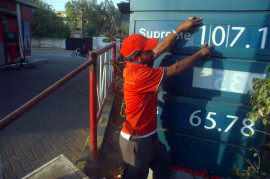
The recent upsurge in the rate of inflation is unprecedented. The Sensitive Price Index (SPI), which consists primarily of ‘kitchen items’, of prime importance especially to the poor, has risen very rapidly since early June 2013. The rate of inflation at that time was four per cent, which has approached 16 per cent by the end of the third week of November. During the five and half months of the present government, the cumulative increase in the SPI has been 11 per cent.
The first shock to prices was the budget of 2013-14, which included a hike of one percentage point in the standard GST rate from 16 per cent to 17 per cent. Subsequently, for some consumer items, this was raised to three percentage points. In addition, higher withholding tax rates were transmitted on to higher prices.
This was followed by a big jump of 35 per cent on average, in industrial and commercial tariffs, with a general impact on the cost of production. Further, if the recent increase in domestic power tariffs is factored into the SPI, this will raise the inflation rate by two more percentage points to almost 18 per cent.
The government has continued to fuel demand-pull inflation by printing of large amounts of money. Currently, the borrowing from the SBP in just over four months stands at Rs730 billion, 44 per cent more than the borrowing in the whole of 2012-13.
Meanwhile, the rupee has continued to depreciate due to the persistent decline in foreign exchange reserves. It has fallen by over nine per cent since the beginning of June 2013. Prices of imported items have gone up as a result even though commodity prices have been stable or falling, with the exception of oil. Consequently, the price of petrol has gone up by 13 per cent and that of HSD oil by 12 per cent.
The price, in particular, of the staple food item, wheat flour, is up by 25 per cent in relation to the corresponding period of the previous year. This is the consequence, first, of a disappointing crop, with a shortfall against the target of over 1.5 million tonnes and second, the setting of a high issue price of Rs1,330 per 40kgs which has put further pressure on the price.
Vegetables have seen extraordinary escalations in prices, of 188 per cent in the case of tomatoes, 125 per cent in potatoes and 84 per cent in onions. This is imposing hardships on family budgets. Pakistan is paying the price for ignoring the production of ‘minor crops’, which include vegetables. The production of such crops has fallen by six per cent since 2007-08 in the face of a growing population. In 2012-13, Pakistan met over one-third of its consumption of tomatoes with imports from India. But given India’s own shortages, imports up to now, in 2013-14, have been limited.
The roots of the high and spiraling inflation lie, therefore, both on the demand and on the supply-side. At least one of the provincial governments, that of Punjab, is contemplating an incremental food subsidy to the subvention under the BISP. This should be done quickly, followed hopefully by other provincial governments.
Beyond the immediate steps, regulations will have to be put in place and strongly implemented against hoarding, speculation and overcharging in the case of essential commodities. The role of the middlemen will also have to be kept under check. Revival of food production has to be put back high on the policy agenda to ensure a modicum of food security to the people.
On top of this, the process of macroeconomic stabilisation has to be managed by the federal government by restraint in the printing of money and through reduction in the deficit in the external balance of payments to lessen the pressure on the rupee. Otherwise, there is a real danger that inflation could acquire a runaway character.
Published in The Express Tribune, December 1st, 2013.
Like Opinion & Editorial on Facebook, follow @ETOpEd on Twitter to receive all updates on all our daily pieces.
COMMENTS (7)
Comments are moderated and generally will be posted if they are on-topic and not abusive.
For more information, please see our Comments FAQ



















































@gp65: @meekal a ahmed: Thank you for the insights. Far better than the article in question. @meekal a ahmed: still waiting for your blog Sir!
"The roots of the high and spiraling inflation lie, therefore, both on the demand and on the supply-side."
That is too simplistic an explanation. While supply/demand do affect price inflation, that is a short term phenomenon. The real root of the problem for Pakistan's inflationary economy is due to the heavy deficit spending by the government and the resultant decrease in the value of the rupee. Unless and until Pakistan controls the budget deficits and foreign debt, inflation will continue to spiral. Then there is the population bomb that is only going to make matters worse.
@meekal a ahmed: and @gp65: Very informative comments
Excellent. When the government keeps on passing the buck to the citizens it triggers inflation. Lets find what percentage of Taxing push inflation as well as Tax on Taxed money. When you expand money base as well as taxes it should slowed down inflation but not happening in Pakistan. Its time to clear regulatory bottlenecks or bring reform in opening up economy. There must be a sincere effort on Pakistan Custom efficiency.
Pasha Sahib,
You are talking of the "headline rate" which is erratic by nature. I always like to look at the "core rate" or the "core trimmed mean" to establish underling inflation pressures. If that is rising (and at one point it was rising while the headline rate was falling and everyone got very excited), it suggests that inflation has developed a strong underlying momentum and it will be devilishly difficult to arrest.
I liked your final paragraph. But, alas, no one will read it, far less pay attention to it. They are too busy doling out concessions and concocting new amnesty schemes. Of the 26 demands presented by the fat-cats, the government has accepted 25 and the last one is under consideration, and we all know which way that is going to go).
How can we borrow almost Rs 6 billion PER DAY (a level which has left the PPP looking like angels), and think it's effects will be benign?